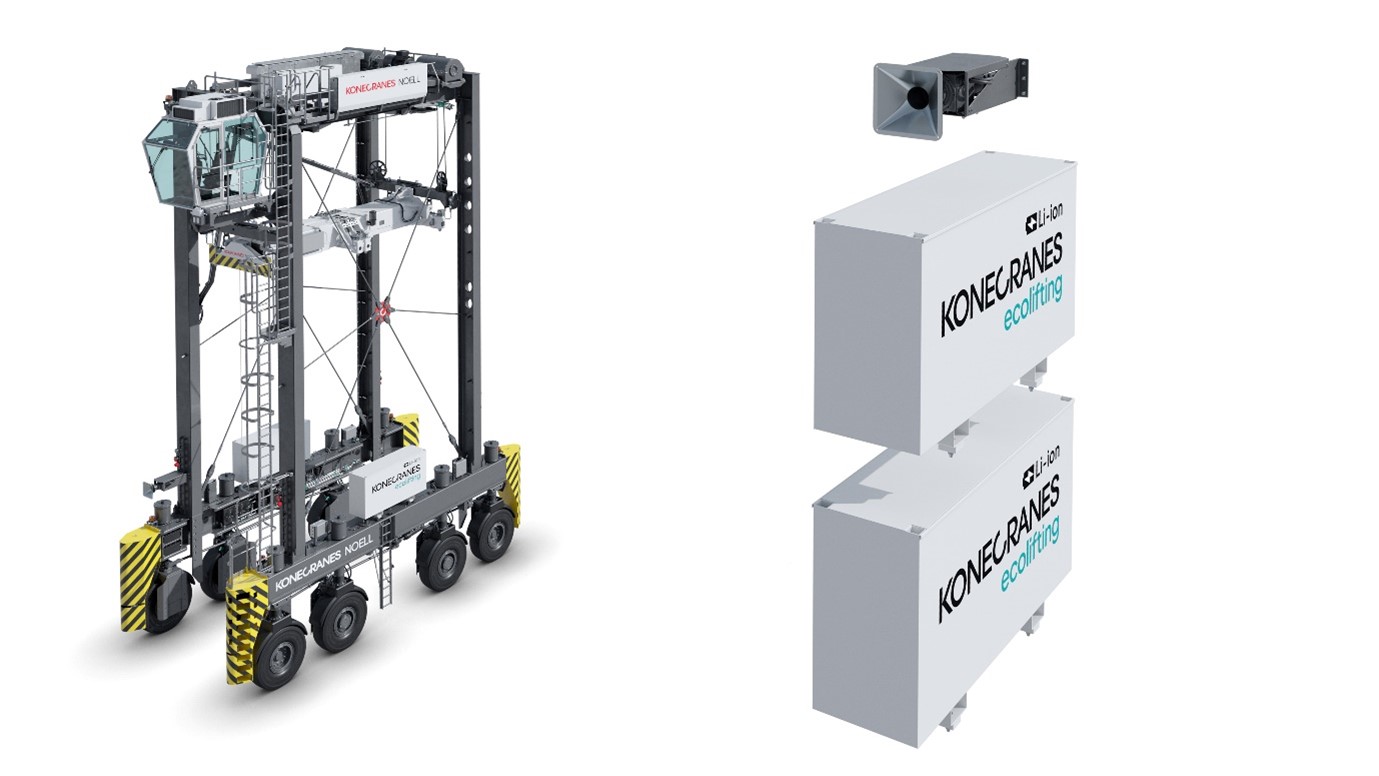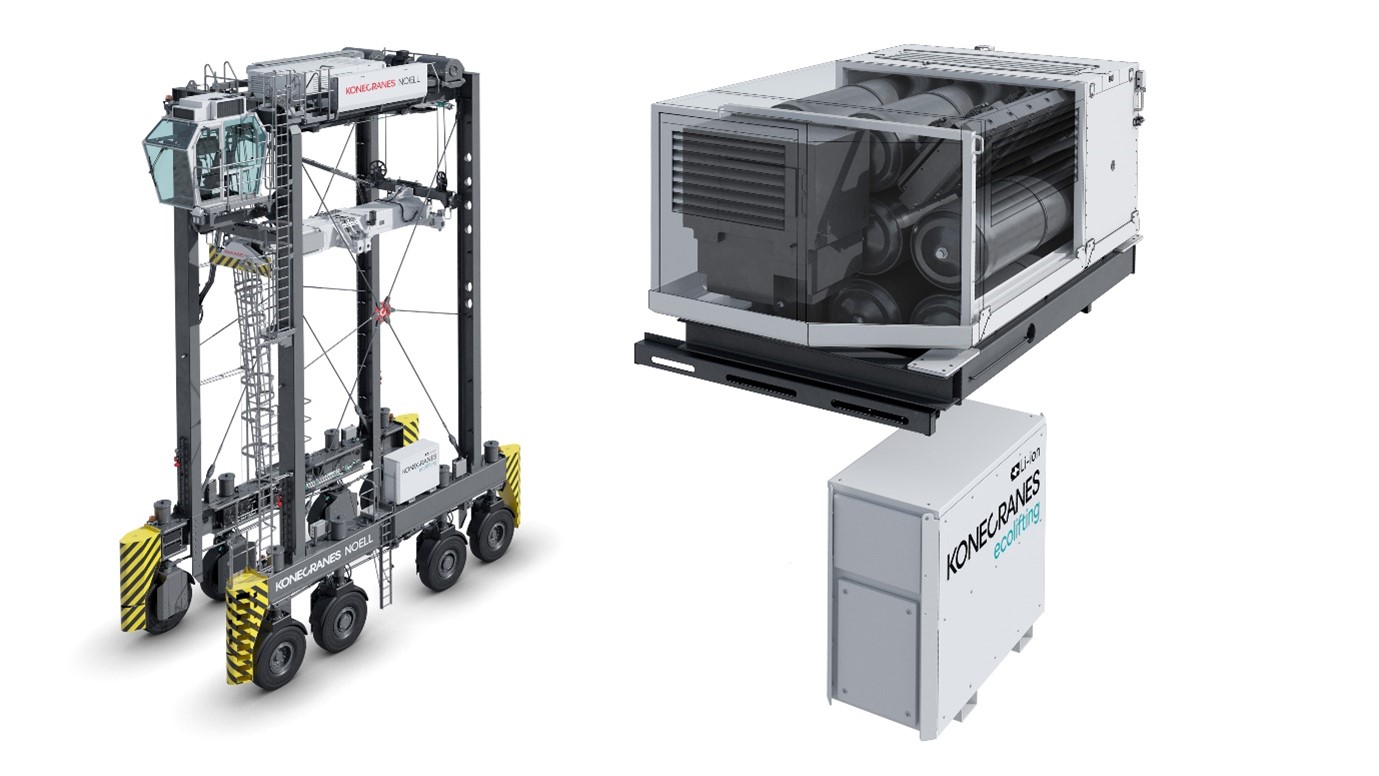Straddling all power options
In 1968 Konecranes introduced the PPH 30 S, their first-ever straddle carrier, used to move standardized containers at the Port of Hamburg. These pioneering straddle carriers featured the latest in diesel-driven lifting technology. They were easy to operate and required no special yard infrastructure to power them.
As technology advanced, the Konecranes Noell diesel-electric straddle carrier arrived in 2001, improving energy efficiency by transforming the mechanical energy of the diesel combustion engine into alternating current to power electric motors. An inverter adjusted the current to adapt to rapidly changing load demands. This variable electric power, combined with optimized fuel consumption in the diesel engine, significantly lowered CO2 emissions.
Today’s global logistics industry is responding to the urgency of climate change with a strong shift away from fossil fuels. Konecranes offers customers a path to zero tailpipe operations with Ecolifting, which further minimizes and eventually eliminates the CO2 associated with container movements.
The new-design Konecranes Noell Straddle Carrier, introduced in June 2024, provides a flexible path to Ecolifting by upgrading through simple interchangeable power modules - hybrid to battery to hydrogen - with no compromise in performance.
Hybrid strads: the popular choice

New-design hybrid Konecranes Noell Straddle Carrier, introduced in June 2024
On the new-design hybrid Konecranes Noell Straddle Carrier, the hybrid power module builds on the tried-and-true diesel-electric design by taking it one step further. Instead of generating electric power and using it immediately, a battery can store power generated from operating phases with low power demands for future use – operating phases with high power demands. The battery can also be topped up with recovered energy from the gantry and hoist motor. This is a much more efficient use of energy.
Considerable power can be stored in the battery, so this hybrid strad utilizes a downsized genset, reducing fuel consumption and overall CO2 emissions. A hybrid machine requires sophisticated software to manage the two energy sources of diesel and battery. Since the combustion engine provides the charge autonomously, and the battery acts as a buffer for peak power demands, no charging points are needed.
Although hybrid is more energy-efficient than diesel-electric, the best diesel engine can only offer 40% efficiency, compared with 95% for electric motors. But implementation is quite easy because the infrastructure does not need to be adjusted, and the operational pattern of the strad fleet does not need to be changed. This makes hybrid straddle carriers a popular option in the long-term goal to reduce carbon emissions.
Hybrid is the current norm in container terminals using strads around the world. It’s the first of the three power options available with the new-design Konecranes Noell Straddle Carrier.
Battery power: the transition to zero tailpipe operations

New-design, battery-driven Konecranes Noell Straddle Carrier
The battery power module takes straddle carriers an important step along the path to Ecolifting by removing the diesel genset altogether. In its place, a compact, high-performance battery pack transforms the machine into a fully electric mobile container handling unit that produces zero CO2 emissions.
With no diesel fuel, operators can both save on fuel costs and eliminate tailpipe emissions simultaneously. Charged on the harbor mains, high-capacity lithium ion (Li-ion) batteries ensure maximum continuous operating time. Electric power gives less vibration and noise, leading to less maintenance and more ergonomic operation. Depending on the size of the fleet, a brownfield container terminal can adopt battery-powered straddle carriers with certain yard adjustments.
Using only batteries as a power source is more energy-efficient than the hybrid solution, but their large size requires time and considerable current to charge. It takes longer to recharge them than to fill a diesel fuel tank, so they need more downtime to power up. Also, not every public power grid has the capacity to cope with the charging requirements of a large fleet of battery-powered straddle carriers. Operators need to develop a charging strategy, organized around work cycles, shift schedules, and the local electricity supply.
However, new battery technology is constantly increasing efficiency with shorter charging times and longer lasting charges, while electricity providers are becoming more environmentally responsible. Port electrification projects are making the transition to battery strads a reality. It’s the second of the three power options available with the Konecranes Noell Straddle Carrier.
Hydrogen: a miraculous fuel

New-design, hydrogen-driven Konecranes Noell Straddle Carrier
The hydrogen power module is a revolutionary step on the path to Ecolifting: the genset of the hybrid strad is removed and replaced with a hydrogen fuel cell. The straddle carrier becomes a high-performance container handling machine that emits just a little water vapor from its tailpipe.
The hydrogen-powered straddle carrier can run up to 12 hours without fuel breaks and refuels in 15-20 minutes. With the same smooth movements as an electric unit, it has similar low maintenance requirements and ergonomic operation. There’s no need to make major changes to terminal design or plan operations around a charging schedule. Hydrogen is a particularly good way to eliminate carbon emissions when the local power grid lacks capacity or reliability.
Although hydrogen is not yet widely produced as a fuel, one of the most common sources is industries in which hydrogen is a byproduct. Some locations have already introduced hydrogen pipelines, but installation is not easy. If pipes are not yet available or it’s not practical to install them, the gas can also be shipped in by tanker trucks. Storage needs special equipment that maintains a high pressure.
Hydrogen is not new as a fuel source, but modern technology has enabled more innovative applications and improved safety. As it gets more cost-efficient, terminal operators should be hydrogen-ready. It’s the third of the three power options available on the new-design Konecranes Noell Straddle Carrier.
Looking ahead
The new-design Konecranes Noell Straddle Carrier is built for durability and a long service life, so it is adaptable to changing needs. The easily interchangeable power modules offer high flexibility as ports transition all the way down to zero tailpipe operation.
The new-design Konecranes Noell Straddle Carrier is ready for what comes next. Although hydrogen is the most advanced carbon-free energy source available today, something may eventually take its place. When that time comes, port and terminal operators with Konecranes Noell Straddle Carriers in service will be able to enjoy the benefits of that new power innovation immediately. They can just swap the power module without having to replace their entire fleet.
Whether it’s hybrid, batteries, hydrogen or something else, straddle carriers can now be run with much more eco-efficiency, reduced emissions, and better performance. The path to Ecolifting reflects the values of Konecranes as we work with our customers to protect our environment while we build success together.



